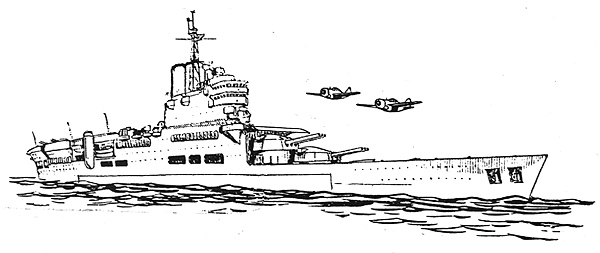





| Displacement | Ijsselmeer 29,000 tons |
Molucca 29,000 tons |
| Armament | 3 x 3 11" Main Med. and Light AA |
2 x 3 11" Main Med. and Light AA |
| Aircraft | 2 floatplanes | 36 |
| Speed | 34.5 knots | 34.5 knots |
| VTS Rating(s) | 3 3 8 | 2 2 8 |
To protect their interests in the East Indies, the Dutch Navy envisioned three trim battlecruisers similar to the German Scharnhorst but smaller and speedier. The government demanded an aircraft-capable ship for the far-flung islands of Indonesia, so Dutch naval architects studied contemporary designs such as Germany's CBV Graf Fitti, Japan's BBV Ise, and the American CLV Tiburon. The Dutch then built the fastest, most heavily-armed "flight-deck cruiser" in the world. The BCV Molucca had a relatively short flight deck and hangar but American-style aircraft accommodation meant that it could carry a moderate number of aircraft. With its large-caliber guns it could defend itself against surface attack better than any cruiser. Brewster provided the new "Bison" fighters and "Buccaneer II" dive bombers (both rejected for use by the USN, but approved for export).
The Ijsselmeer was built as designed with nine 11" guns bought from Germany, now abandoning plans for more P-class panzerkreuzers like Posen. The third Dutch battlecruiser was postponed and never laid down.
Molucca and Ijsselmeer operated out of Djakarta and joined together with the British CV Incomparable, BC Superb, and destroyers for a potent battle group. Avoiding the crushingly powerful Japanese naval force now descending on Malaysia after Force 'Z' was sunk, together they raided Japanese forces east of the Philippines. Engaging a heavy enemy scouting force, planes from Molucca sank Chikuma and air-raided Truk. Retreating to Ceylon after both Singapore and Djakarta fell to the Japanese, Molucca and Ijsselmeer sortied with a polyglot Allied force that challenged a Saxo-Nipponese armada in the Arabian Sea. New Helldivers aboard Molucca concentrated on Mutsu and sank her, but Graf Zeppelin's See Stukas blew out Molucca's elevators. Refitting in the USA, Molucca emerged to assist in the Allied reconquest of Java. Ijsselmeer, operating with Molucca and the Royal Italian CV Aquila, was surprised by a fast Japanese surface fleet that had passed through the Sunda Strait at night. Molucca and Ijsselmeer charged the enemy, sinking two cruisers and damaging a battleship, but succumbed to Long Lance torpedoes fired from an incredible 40,000 yards away.


